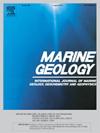High-resolution seabed sediment information is critical for a range of marine spatial planning applications in multi-use shelf environments. To establish this information for the Bay of Fundy, Canada, legacy seabed sediment measurements were obtained from regional data compilations, and eight parameters describing the grain size were modelled across the extent of the bay using high resolution acoustic seafloor mapping and oceanographic datasets. This was achieved using a purpose-made convolutional neural network configured for geospatial modelling of multivariate grain size parameters. Shared information between the response parameters enabled model training with partially complete observations from the varied legacy data sources, and an explicit multiscale model architecture ensured that environmental predictors were implemented at appropriate scales for modelling each parameter. This avoids typical exhaustive exploration and selection of scale-specific predictor sets that often precede model building. Compositional grain size parameters were additionally accommodated using appropriate output activation functions, providing an efficient alternative to compositional data transformation and imputation. Results agreed well with our current understanding of the surficial geology of the bay, and cross-validation was used to quantitatively evaluate map predictions. Of the eight predicted parameters, the mean grain size and mud (clay and silt) fractions were predicted with high accuracy (> 50% variance explained); the accuracy of grain size skewness was comparatively low (24% variance explained). Exploration of variable importance suggested that compiled acoustic backscatter was the most important environmental variable for predicting the grain size, but that geographic information describing the latitude and longitude within the bay was also highly useful. We hypothesize an interaction between these variables that enables location-specific prediction. Data layers of predicted grain size parameter values are made available for further sedimentological and ecological exploration, and for marine spatial planning activities within the bay.


